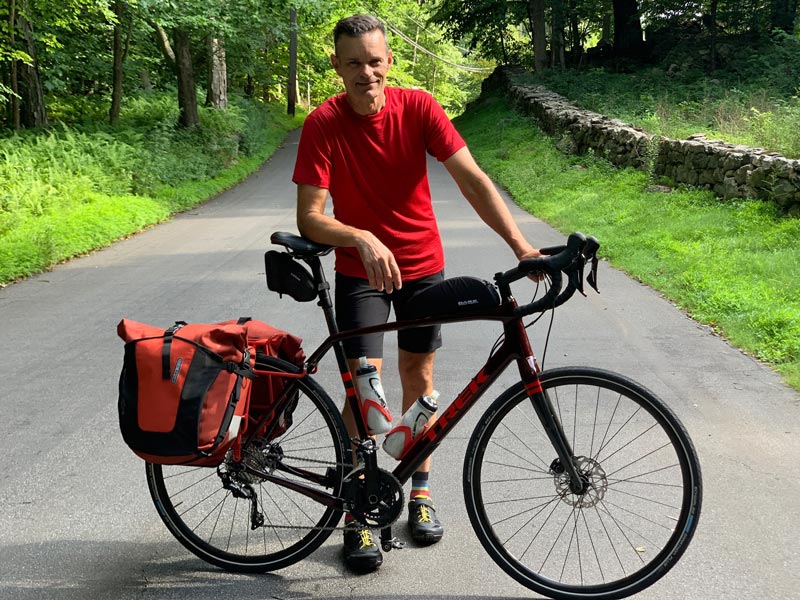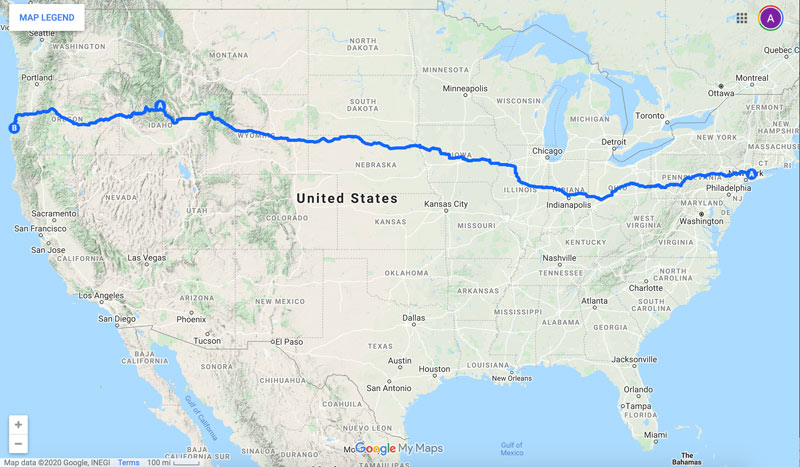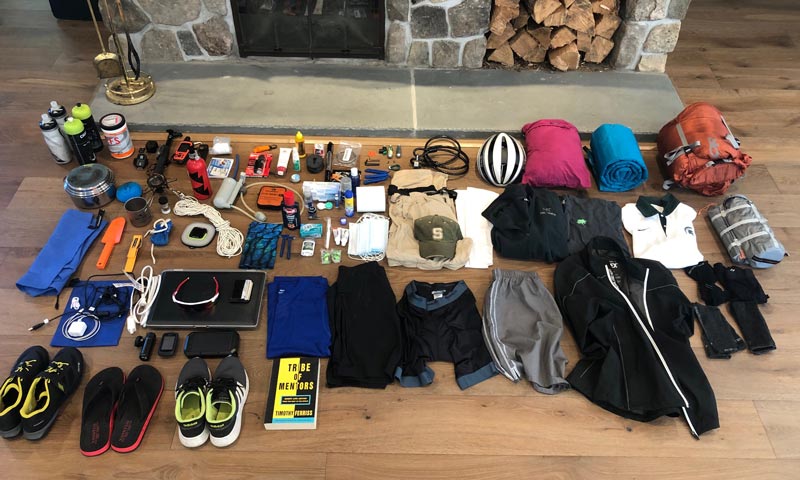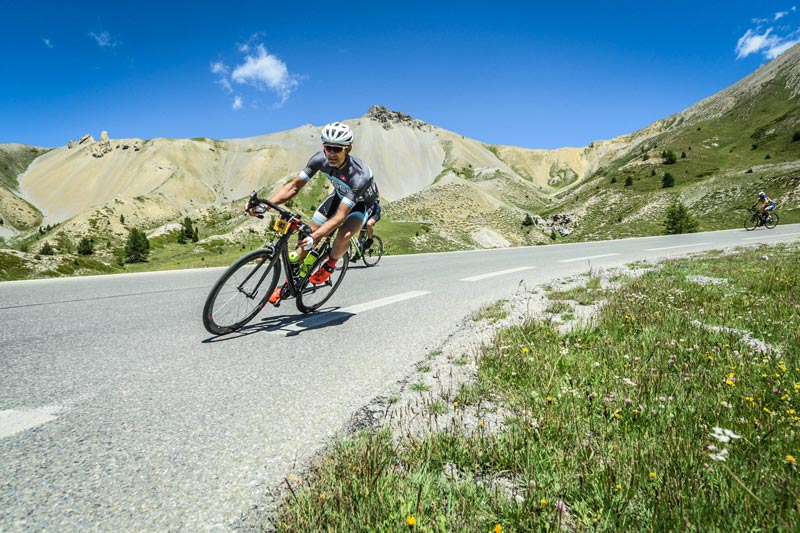
Ken Benoit, CGCS, will blend two of his interests — cycling and golf course environmental stewardship — on his cross-country Connect to Protect Tour beginning Aug. 14. Photos courtesy of Ken Benoit
The Venn diagram charting those folks passionate about cycling and those infatuated with golf course best management practices (BMPs) converges at the most miniscule of points.
That’s where you’ll find Ken Benoit, CGCS, at least metaphorically. Physically, starting Friday, Aug. 14, you’ll find him somewhere between the United States’ east and west coasts, championing the latter of those two passions from atop the saddle of the former.
Benoit, a former two-decade-plus golf course superintendent, immediate past president of the Metropolitan GCSA, executive director of the New York Golf Course Foundation and a 26-year GCSAA member, plans to pedal his way across America while peddling the benefits of facility adoption of BMPs.
“The impetus was, initially, my trying to figure out the next step in my professional career,” says Benoit, 56, who last year left the day-to-day business of working as a golf course superintendent to start his own company, Eco Turf Consulting. “I started up this business, and I was having a hard time finding some direction. To be frank, I wasn’t thinking with true clarity, and I had felt that way for a while. Then this COVID hit. It was a tough go for everybody. So I had this lack of clarity, and I had always wanted to ride my bike across the country. That had been a goal of mine, and I came up with this idea, of being isolated and blowing the carbon out, essentially, and approached my wife with the idea. She instantly said yes. She recognized that I had been struggling a bit.”
At that point, Benoit’s bike tour was just that — a bike tour. As he started pondering the logistics of a self-propelled trip across the U.S., though, thoughts of his other passion project, golf course BMPs, kept creeping in.
Long a champion for BMPs — the state-centric guidelines that promote environmental stewardship and sustainability on golf courses — Benoit played a key role in New York’s establishment of BMPs, and the New York Golf Course Foundation was an offshoot of that. GCSAA’s goal is to have BMPs established in all 50 states by the end of this year, and as that initiative reaches its conclusion (37 down, 13 to go), Benoit turned his BMP thoughts to the next step: the establishment of BMPs, using the state model, at the facility level. And he thought about using his bike trip as a platform.
So it was back to his wife, Melodee, and again, she was all for it.
Benoit mentioned the tour to a few of his superintendent friends, and one in particular — Nathan Wattier, a former intern under Benoit and a three-year GCSAA member in his first year as superintendent at Oeschberghof Resort in Donaueschingen, Germany — had an epiphany.
“He said, ‘Ken, I have a great idea: You should offer a free BMP consulting visit for every course who wants one along the route,’” Benoit recalls. “I thought that was a great idea. This is a platform for promoting BMPs, and a way to promote that platform is by doing consulting. That jump-started the process I wanted to start from the beginning, to gain some clarity in my life. I’m super excited. I feel I have direction again.”
Technically, that direction is west.
On Friday, Aug. 14, Benoit plans to dip his rear tire in the Atlantic Ocean in Greenwich, Conn. If the Connect to Protect Tour proceeds as expected, 40 days (and 3,300 miles) later, he’ll dip his front tire in the Pacific in Coos Bay, Ore.

Benoit’s planned route for the Connect to Protect Tour.
Between those ceremonial acts, Benoit plans to pedal and preach, not necessarily in that order. He’ll cycle roughly 100 miles per day for 33 days. He’s allowing for rest and weather days.
When not on his bike, he’ll be perched on his proverbial pulpit, consulting with superintendents about ways they can adapt state BMPs to fit their specific conditions, and — importantly, he says — ways in which they already are. As of the end of July, Benoit had seven course visits scheduled.
At night, tucked away in his (wired) tent, he’ll knock out blog and vlog posts about his trip and his visits.
“I don’t anticipate writing a big, long, formal report,” he says. “I look at the visits as a way to interact with superintendents. They’re interested, obviously, in BMPs. I’ll use my experience to review their facility and make recommendations to them, which they can take or leave. And I’ll take a BMP that they’re already excelling at and create a blog about it. It’ll be positive. Ultimately, the goal is to raise awareness. But the visits have two main goals: One is to help superintendents better align their facilities with BMPs, and the other is to highlight what they’re already doing well in regard to BMPs.”
Trip planning was relatively straightforward. The Connect to Protect Tour — Benoit has started a GoFundMe fundraiser to help defray costs — starts in Greenwich, just south of Benoit’s Bedford, N.Y., home. Coos Bay was identified as the western terminus because that’s where his sister lives. Benoit also wanted to roll through State College, Pa., to pay a visit to buddy and noted turfgrass scientist John Kaminski, Ph.D., who has volunteered to help upload blogs and vlogs — professional and also those more personal in nature — to Benoit’s website.
One superintendent near Indianapolis expressed interest in a visit, which played well with Benoit’s desire to stick to a path well north of the Mason-Dixon line (extended west). Benoit plotted a general route in consultation with the folks on Warmshowers.org, an online community of bicycle travelers who offer their homes as waystations for those on long-distance bikepacking trips. Then it was just a matter of connecting the transcontinental dots through 13 states.
“There’s been a lot of planning that goes into this,” Benoit says, “determining the best route, what I need to take with me. I’ve done a lot of research. I’ve never done this before, but I grew up backpacking. I grew up in a family of outdoor lovers. We used to camp. I’ve done versions of what I need to do. Now, I’ve never done a 40-day version. This will just be on a bigger scale.”
Benoit plans to be self-supporting. He’ll carry 40 to 50 pounds of gear — on- and off-bike clothing, bike parts, tools, tent, toiletries — in panniers and a bento bag attached to his bike. He plans to stop regularly to refill water bottles, and he’ll buy food at groceries along the way.
“Basically, I’ll be carrying with me everything I need to survive,” he says.
The ongoing coronavirus pandemic presents obvious complications, but also motivation.
“Listen, most of us have probably been struck and maybe even surprised by how we Americans are handling this current crisis,” Benoit says. “Part of this trip I hope to use to regain my faith in America. I haven’t been very impressed. I’m not talking about the politics of it, although that is a part of it. I mean the straightforward concepts of protecting one another, your obligations as an American citizen. I hope to restore some of that faith in the American people to myself. That’s a personal thing. It’s not me trying to restore Americans’ faith in each other — that’s a bigger concept than what I could take on. It’s really for me.”
Included in his gear stash will be gloves, masks and lots of hand sanitizer — “Stuff I’d never take for another ride,” says Benoit, a longtime, and competitive, amateur cyclist. In non-pandemic times, he might stay inside a host’s home; instead, this time, he’ll pitch a tent in residential lawns.
“I’ll be camping, but a lot of it is camping in somebody’s backyard,” he says. “I’ll still be able to use electrical outlets and charge stuff. It’ll be safer. Because I’ll be alone for such long stretches, I’ll probably be one of the most COVID-free guys in America. The amount of isolation I’ll have over the course of 40 days ... I’ll only be mixing it up when I’m going into grocery stores or making course visits, and it’ll all be socially distanced and wearing a mask. I’ll be wearing a mask everywhere I go, just not while riding the bike.”

Tools for the trek: Some of the gear Benoit will carry coast to coast.
In peak form aboard his sleek racing bicycle, Benoit might average in excess of 20 mph on competitive rides. For this tour, he purchased a cyclocross bike. Though it has similar geometry to his go-fast ride, it’s geared more toward comfort, with wider tires, disc brakes and frame mounts for his panniers. His training has similarly shifted from top-end speed runs to long slogs. He expects to average closer to 13 to 15 mph on his Connect to Protect Tour.
“It’s just natural not to be going as fast,” Benoit says. “You want to be able to survive. I’m not going to try to kill myself to get my speed up. What’s the point? One hundred miles is 100 miles. You have to be able to do another 100 tomorrow. And the next day.”
That factored into his timing, too. Though a trip later — or earlier — in the year would ensure lower temperatures, it would also limit daylight.
“Longer day lengths were critical,” Benoit says. “If I started in September, the weather would be great in the Midwest, but I bet it would be cold going across the Continental Divide. As it is, days are going to be getting shorter and shorter and shorter. We’re talking about a 40-day trip. That’s a lot of lost daylight.”

Benoit competing in the L’etape du Tour — a race for amateur cyclists — in the French Alps in 2017. He finished in the top 5%.
After his tour and a short rest, Benoit plans to rent a car, sling the bike on a rack and drive back home. That will allow him to detour to any courses whose superintendents might have requested a visit but that are located just a bit too far off the bike path. He might detour through Lawrence, Kan., to pay a visit to GCSAA headquarters, which lies about 200 miles south of Benoit’s east-to-west route at its closest point.
And while the Connect to Protect Tour, at some level, is about big-picture thinking — golf and BMPs and, by extension, the environment and the world at large, as well as a big chuck of the people in it — it’s also about one man’s need to discover the soul of the country. And have a little fun along the way.
“Breaking away from being so inundated with the daily news cycle will be a big benefit to me,” Benoit says. “There’s not a lot of positive news to watch these days. It can be depressing. Although I have some big, broad goals, I also hope to have fun. There’s nothing wrong with combining work with pleasure. This is a trip that is going to require some effort, some work — blog posts, visiting courses. But I get to ride my bike across the U.S. That’s pretty cool.”
Andrew Hartsock is GCM’s managing editor.